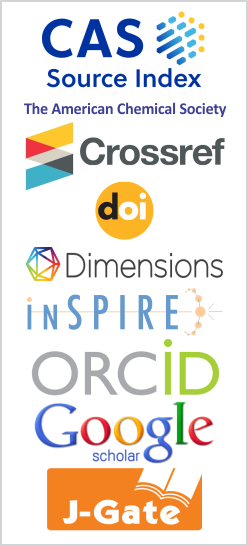Study of Lowest Odd Parity Configurations in Ge-I Like Ions
DOI:
https://doi.org/10.26713/jamcnp.v3i1.344Keywords:
Energy levels, Oscillation strength, ab initio calculations, Isoelectronic sequence, Transition probabilitiesAbstract
Fine structure energy levels, transition probabilities and oscillator strength for terms belonging to the ground configuration,Downloads
References
J.D. Gilaspy, J. Phy. B, At. Mol. Opt. Phy. 34, R93 (2001).
K. Rahimullah, M.S.Z. Chaghtai and Khatoon, Phys. Scrip. 18, 96 (1978).
C.E. Moore, Atomic Energy Levels 2, 467 (1952).
Y.N. Joshi and C.J. Budhiraya, Can. J. Phys. 49, 670 (1970).
E. Biemont and J.E. Hansen, Physica Scripta 33, 117 (1986).
R.D. Cowan, Phys.Rev. 163, 54 (1967).
G. O'Sullivan, J. Phys. B 22, 987 (1989).
U. Litze ´n and J. Reader, Phys. Scr. 39, 468 (1989).
M. Rainer, J. Phy. B 35, 3411 (1989).
R.D. Cowan, The Theory of Atomic Structure and Spectra, University of California Press, Berkeley, CA (1981).
D.R. Hartree and E.E. Salpeter, Quantum Mechanics of One- and Two-electron Atoms, Springer-Verlage, Berlin ” New York (1957).
I. Sobelman, Atomic Spectra and Radiative Transitions, Springer, Berlin (1979).
J. Sugar and A. Musgrove, J. Phys. Chem. Ref. Data 22 (1993), 1213.
L. Kelly, J. Phy. Chem. Ref. Data 16, 1298 (1987).
H. Li and L. Andrew, J. Opt. Soc. Am. 61, 96 (1971).
J.E. Sansonetti and W.C. Martin, J. Phys. Chem. Ref. Data 34, 1559 (2005).
A. Tauheed and Hala, Phys.Scr. 85, 9 (2012).
A. Tauheed, Y.N. Joshi and S. Jabeen, Phys. Scr. 78, 65305 (2008).
A. Riyaz, K. Rahimullah and A. Tauheed, J. Quant. Spectros. Radiat. Trans. 133, 624 (2014).
M. Raineri et al., J. Phys. B 35, 3411 (2002).
E.B. Saloman, J. Phys. Chem. Ref. Data 36 215 (2007).
D.C.J. Rezende et al., J. Quant. Spectrosc. Radiat. Transfer 111, 2000 (2010).
J.E. Sansonetti, J. Phys. Chem. Ref. Data 37, 1183 (2008).
J.E. Sansonetti, J. Phys. Chem. Ref. Data 41, 13102 (2012).
T. Shirai et al., J. Phys. Chem. Ref. Data 8, 486 (2000).
Downloads
Published
How to Cite
Issue
Section
License
Authors who publish with this journal agree to the following terms:- Authors retain copyright and grant the journal right of first publication with the work simultaneously licensed under a CCAL that allows others to share the work with an acknowledgement of the work's authorship and initial publication in this journal.
- Authors are able to enter into separate, additional contractual arrangements for the non-exclusive distribution of the journal's published version of the work (e.g., post it to an institutional repository or publish it in a book), with an acknowledgement of its initial publication in this journal.
- Authors are permitted and encouraged to post their work online (e.g., in institutional repositories or on their website) prior to and during the submission process, as it can lead to productive exchanges, as well as earlier and greater citation of published work.




